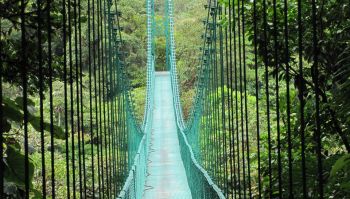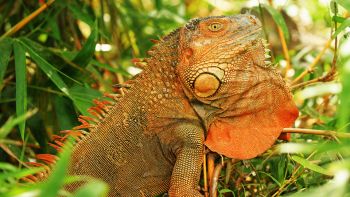Arrival
The simplest and least expensive way to travel from Europe and North America is by plane. Prices vary seasonally between about 800 - to 1,000 Euros. As an alternative, a crossing with a cargo ship is possible, apart from a much longer journey time you will need to allow for significant additional costs and a lengthy search for a suitable passage.
If you enter Costa Rica from Nicaragua in the north, the frontier check point is situated near Peñas Blancas. When entering from Panama in the south, there are two frontier check points. The main check point, close to Paso Canoas, is located on the Pan American Highway; the smaller check point is located at Sixaola.
Visa Requirements
European Union and Swiss passport holders will be granted a 90 day visa on presentation of a valid passport with at least 6 months before expiry. Those who wish to stay longer may apply for an extension at the immigration officer in San Jose or leave the country for at least 3 days.
The English-speaking website of the Costa Rica Tourism Board provides updated information about the COVID-19 entry requirements: https://www.visitcostarica.com/en/costa-rica/planning-your-trip/entry-requirements
Please do not pack the following: fresh fruit or vegetables, and meat products.
Prescription Drugs: Please adequately label any drugs/medication
Vaccinations
Currently there are no mandatory vaccinations.
A valid yellow fever vaccination for all travellers older than 9 months will be required when entering from a yellow fever area and must be demonstrated through an international vaccination certificate. You can only travel ten days after yellow fever vaccination. Non-compliance threatens a travel ban.
We would recommend tetanus and polio protection and under certain conditions a Malaria prophylaxes. Costa Rica is classified as "Zone A" a low and seasonal malaria-related risk by the World Health Organization. For detailed information, please contact your family doctor and / or the Institute of Tropical Medicine in your own country.
Money and Foreign Exchange
The Costa Rican currency is the Colón. There are coins in denominations 5, 10, 20, 25, 50, 100 and 500 Colones, bank notes in the following denominations 1,000, 2,000, 5,000, 10,000 and 20,000 Colones. The reserve (second) currency is the U.S. dollar.
Money exchange at the airport is very expensive!
In the tourism areas, hotels and excursions, prices are often quoted in U.S. $, and can always be paid in either Colones or U.S. dollars. Nationally there are over 600 ATMs where cash can be withdrawn using credit cards and bank cards. Do not forget your pin number!
The most common credit cards are Visa, MasterCard and American Express.
Banks are open 9am to 3pm. Changing money at a bank is a long procedure. Please make sure you have your passport when you want to change money at a bank. Currency can also be changed at most Hotels. For current conversion rates please visit the Currency Converter OANDA.com
Electricity
Standard voltage is 110 V in Costa Rica. Do not forget to bring your own adapter.
Photography
Due to the strong tropical sun we recommend the use of a polarisation filter. Likewise silicone crystals, if you travel to extremely damp areas, rain forests.
These are available in most pharmacies or photo supply shops.
Telephone
Costa Rica has a well developed telephone network, one of the most modern in central America. Within the country there are no area codes. Widely available throughout the country are internet cafes providing Fax and e-mail services. Public telephones operate with coins and prepaid telephone cards that are widely available.
Climate and best time to Travel
Costa Rica is a year round destination. The climate is tropical to subtropical and is very strongly influenced by local altitude and the Cordillera (Continental Divide). Costa Rica is divided into the more humid Atlantic region and the alternating wet Pacific region.
Dry season is from December to April with very light rainfall. In the rainy season there is usually 2 to 3 hours heavy rain in the afternoon. The months with the highest rainfall are October and November. In July and August there is a "Veranillo" (little dry season) with little rainfall. The Caribbean climate in Costa Rica's is exactly reversed. The wettest time of year is from August to October.
Average Sunshine/Rainfall: Puntarenas
|
Month |
Ø Max °C |
Ø Min °C |
ØRainfallmm |
ØSunshinehrs |
|
Jan |
33.8 |
22.0 |
5 |
8.5 |
|
Feb |
34.6 |
22.0 |
3 |
9.0 |
|
Mar |
35.2 |
23.0 |
7 |
9.1 |
|
Apr |
34.8 |
24.0 |
28 |
8.5 |
|
May |
33.2 |
23.0 |
161 |
6.5 |
|
Jun |
32.5 |
22.0 |
230 |
5.2 |
|
Jul |
32.4 |
22.0 |
230 |
5.3 |
|
Aug |
32.5 |
23.0 |
192 |
5.5 |
|
Sep |
32.1 |
23.0 |
260 |
5.3 |
|
Okt |
31.8 |
23.0 |
262 |
5.4 |
|
Nov |
31.7 |
23.0 |
96 |
6.1 |
|
Dec |
32.6 |
23.0 |
36 |
7.5 |
|
Year |
33.1 |
23.0 |
1510 |
6.8 |
Average Sunshine/Rainfall: Limon
|
Month |
Ø Max °C |
Ø Min °C |
ØRainfallmm |
ØSunshinehrs |
|
Jan |
29.5 |
20.3 |
319 |
5.1 |
|
Feb |
29.7 |
20.3 |
201 |
5.5 |
|
Mar |
30.2 |
20.9 |
193 |
5.7 |
|
Apr |
30.6 |
21.6 |
287 |
5.8 |
|
May |
30.9 |
22.2 |
281 |
5.5 |
|
Jun |
30.5 |
22.3 |
276 |
4.3 |
|
Jul |
29.8 |
22.1 |
408 |
3.9 |
|
Aug |
30.2 |
22.1 |
289 |
4.7 |
|
Sep |
29.7 |
22.2 |
163 |
5.1 |
|
Okt |
30.6 |
21.9 |
198 |
5.3 |
|
Nov |
29.8 |
21.6 |
367 |
4.9 |
|
Dec |
29.5 |
20.8 |
402 |
4.9 |
|
Year |
30.1 |
21.5 |
3384 |
5.1 |
Average Sunshine/Rainfall: San Jose
|
Month |
Ø Max °C |
Ø Min °C |
ØRainfallmm |
ØSunshinehrs |
|
Jan |
23.9 |
14.2 |
10 |
7.0 |
|
Feb |
24.0 |
14.3 |
11 |
7.8 |
|
Mar |
26.0 |
14.7 |
12 |
8.0 |
|
Apr |
26.6 |
15.5 |
48 |
7.0 |
|
May |
26.7 |
16.1 |
213 |
5.2 |
|
Jun |
26.5 |
16.1 |
295 |
4.0 |
|
Jul |
25.5 |
15.8 |
221 |
4.0 |
|
Aug |
25.9 |
15.8 |
235 |
4.4 |
|
Sep |
26.6 |
15.5 |
349 |
5.0 |
|
Okt |
25.9 |
15.2 |
326 |
4.4 |
|
Nov |
24.8 |
15.1 |
130 |
4.5 |
|
Dec |
24.1 |
14.6 |
40 |
5.9 |
|
Year |
25.6 |
15.2 |
1891 |
5.6 |
Time Zone
The time difference between Costa Rica and Central Europe during winter -7 hours, during summer -8 hour
Shopping
Opening hours are generally between 9am to 8pm, occasionally longer.
Supermarkets and shopping centres are also open on weekends.
Food & Drink
Costa Rica and other tourist areas have a large selection of exquisite restaurants. The menu includes national and international cuisine, the latter partly “costaricanized”!
Nationwide, there are the so-called sodas. The small restaurants may not sell alcoholic beverages. Soda is the name for mineral water. The menu, if there is one, always offers the "Casado" Rice, beans, coleslaw, fried plantains, local vegetables and choice of beef, chicken, pork, fish or vegetarian are all served. Other typical dishes include "Arroz con Pollo o Camarones" (tropical chicken or shrimp risotto) and olla de carne (beef stew tropical) always served with tortillas (small corn tortillas). The breakfast is gallo pinto (rice and beans with onions, cilantro, peppers baked in a pan) served with eggs. Flan de Coco o Caramelo (coconut or caramel custard), Arroz con leche (rice pudding) or Tres Leches (Milk Cake) are the typical local deserts. In the Costa Rican Bars Boca (Mouth) is served with beer or cocktails. Boca is comparable to the Spanish tapas. Previously Boca had to be served with an alcoholic drink. Various specialties are sold on the street, for example Pejibaye (peach palm fruit), which are eaten hot with mayonnaise, or tamales creamed corn with pieces of meat wrapped in banana leaves, and corn on the cob offered either roasted or boiled. Over the last 20 years the bread culture has taken hold in Costa Rica. Today there is on nearly every street corner a bakery selling baguettes. Very tasty are the differently filled empanadas. The sweet baked goods deserve to be called sweet. On the Atlantic coast of Costa Rica you can indulge yourself with Caribbean cuisine. Rice and beans, where the beans are cooked in coconut milk, this is a typical Caribbean Sunday dish. To accompany, mackerel or chicken, cooked in coconut milk and served hot and spicy. Coffee is prepared in the traditional way using a cloth filter. Other drinks are the internationally known soft drinks. Imperial is the most common brand of beer, other varieties are Pilsner, Bavaria, Rock Ice.
The wine list is international; wines are mainly from South Africa, Chile and Argentina. Another delicacy is the Costa Rican coffee liqueur. The Guaro, the most popular domestic brandy, is distilled from sugar cane, for Europeans it takes a little getting used to.
Crime
The crime in Costa Rica is by international standards average. You should always be cautious; valuables should be carried only for the day requirements and not visible to everyone. It’s best to largely forgo jewellery. In some tourist areas and in the big cities you should not leave your luggage unattended. Park loaded vehicles only at well-guarded parking lots. Public bus passengers should always keep an eye on their luggage. Avoid walks at night in the big cities. Make sure to check the coverage of any possible losses with your travel insurance company.

We would like to thank all our guests who have been travelling with us since 1994 in the most beautiful time of the year - their well-deserved holidays. When developing itineraries for groups and individual travelers, selecting our local service partners and caring about the well-being of our guests, we always focus on the highest possible quality standards. Since the founding of Amadeus Travel, we have been committed to sustainable tourism as the only long-term viable form of tourism, e.g. through our social commitment, visiting and supporting private and state nature reserves as well as the training of our team and experienced, fully licenced tour guides.











 Book Now
Book Now 











